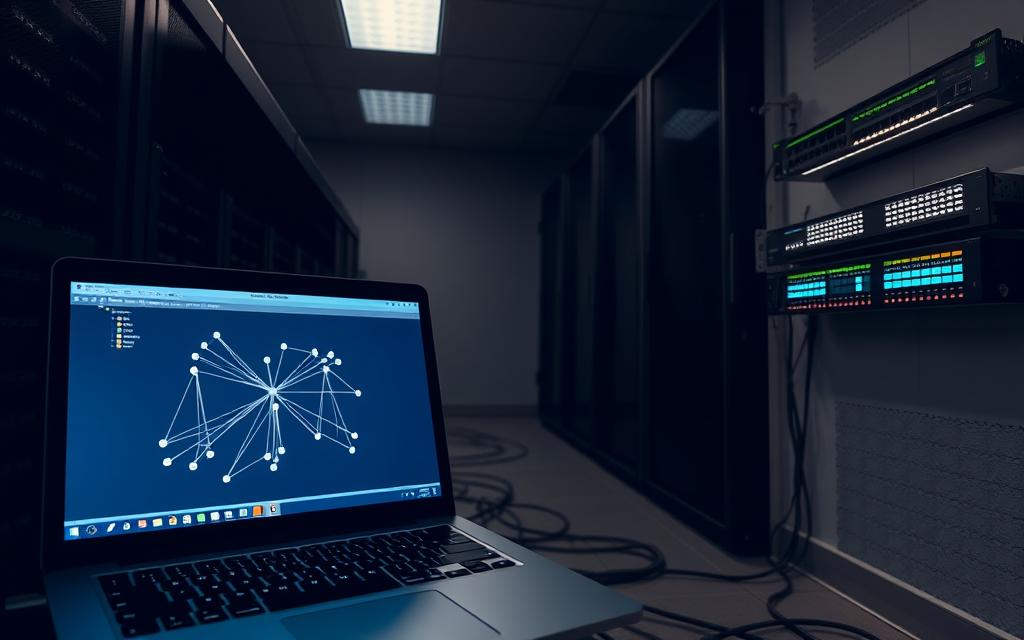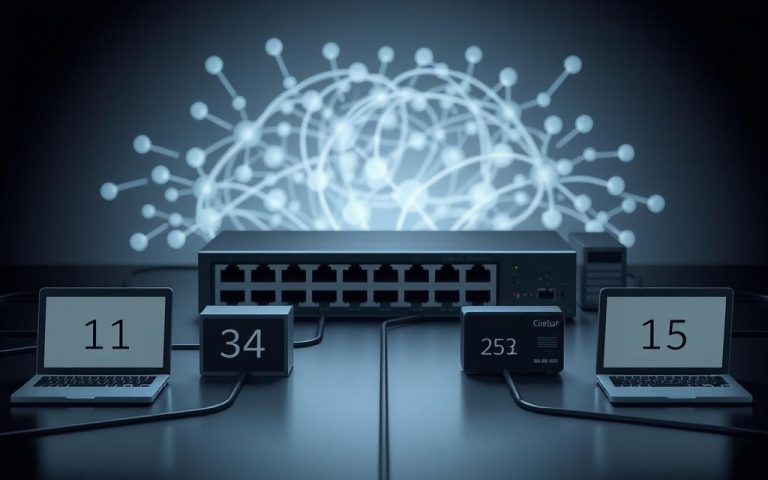Making Your Computer Visible on a Network: Step-by-Step Guide
Computer networking can be tricky, especially when trying to make devices visible. Many users struggle with network discovery, hindering teamwork and resource sharing1. Grasping network connectivity basics is vital for smooth digital interaction.
Network visibility is key for devices to communicate and share resources effectively. About 20-30% of users face challenges when adding new devices to their network1. These issues arise from various technical complexities that can be solved systematically.
Windows 10 users often face specific network setup hurdles. Network configuration and adapter issues cause about 25% of computer visibility problems1. Incorrect Windows updates can worsen network interactions, causing 15% of visibility issues1.
Our guide will help you boost your computer’s network discovery abilities. By applying proper network settings, you can fix most visibility problems. Strategic configuration can resolve up to 60% of network visibility challenges1.
Networking needs a smart approach. Understanding network discovery basics helps you troubleshoot and improve your digital setup. This applies to both small home networks and larger office systems.
Understanding Network Visibility Basics
Network visibility is vital for managing digital infrastructures. It helps organisations secure their tech ecosystems effectively. Network discovery is key to understanding complex network environments.
Exploring Network Discovery
Network discovery lets computers find and talk to each other on local networks. It serves as the foundation for resource sharing and collaborative work. This process helps devices identify resources and set up communication.
It also allows sharing of files and peripherals. Network visibility boosts efficiency, security, and performance in complex data environments2.
- Identify available network resources
- Establish communication channels
- Share files and peripherals
Why Network Visibility Matters
Network visibility is more than just sharing resources. Modern networks face big challenges, like encrypted traffic hiding cyber risks2. Old monitoring tools struggle with cloud environments2.
Effective network visibility is not just a technical requirement, but a strategic necessity for organisational security.
Common Network Visibility Challenges
Organisations face several hurdles in maintaining good network visibility. These include limited monitoring ports and faster network speeds. Complex network structures also pose a challenge.
- Limited monitoring port availability
- Increasing network connectivity speeds
- Complex network infrastructures
SD-WANs improve visibility by routing traffic through managed cloud services2. Good network visibility is crucial for following rules like HIPAA and PCI DSS2.
Essential Network Components and Requirements
Modern networks need sophisticated hardware for top-notch connectivity and performance. Understanding key components is vital for creating an effective network setup.
The core hardware elements form the backbone of any network configuration. These include routers, switches, Ethernet cables, and network adapters.
- Routers: Central devices managing network traffic3
- Switches: Expanding network connectivity options3
- Ethernet cables: Providing reliable wired connections4
- Network adapters: Enabling device communication
Strategic hardware placement is crucial for network visibility. Dual-band routers can boost efficiency by up to 50% in multi-device settings4.
The average household now connects about 10 devices. This makes a robust network infrastructure essential3.
Key network configuration considerations include:
- Implementing Dynamic Host Configuration Protocol (DHCP) for automatic IP assignment5
- Ensuring robust security measures
- Optimising wireless access points
Wireless technologies are evolving rapidly. Wi-Fi 6 can now deliver speeds up to 9.6 Gbps4.
This advancement highlights the importance of understanding network setup principles. Staying updated helps create efficient and high-performing networks.
How to make your computer visible on a network?
Network discovery can be tricky for many users. It’s vital to enable network services and configure settings properly. This guide will help you make your computer visible on a network.

Checking Network Discovery Status
Network discovery status depends on your network type. Most Windows 10 users have it enabled on private networks. Public networks typically have network discovery turned off by default6.
- Verify current network profile settings
- Check network discovery preferences
- Identify potential connectivity issues
Enabling Required Network Services
Proper network setup involves activating critical services. File and printer sharing happens automatically for most users on private networks6. Key services to enable include:
- DNS Client service
- SSDP Discovery service
- UPnP Device Host
Many users find network profile settings confusing. Experts suggest carefully choosing appropriate profiles to prevent unauthorised access6.
Configuring Network Settings
To enable network discovery, focus on these key points:
- Set correct network profile (private or public)
- Adjust firewall settings
- Verify IP address configuration
Pro tip: Always be cautious when modifying network settings to maintain system security.
For public networks, set your profile to Public. Most experts recommend this to avoid potential security risks6.
Configuring Windows Firewall Settings
Windows firewall protects your computer from threats while maintaining network connectivity7. It acts as a digital shield, monitoring incoming and outgoing network traffic8.
Users should consider several key points when configuring firewall rules. Windows Firewall is enabled by default on all Windows 11 PCs7.
- Windows Firewall is enabled by default on all Windows 11 PCs7
- 90% of users can allow specific apps through the firewall without complete disablement8
- Custom inbound and outbound rules can be created for specific network requirements7
Try these strategies to manage network security effectively. Choose between Domain, Private, or Public network profiles8.
- Network Profile Selection: Choose between Domain, Private, or Public network profiles8
- App Access Control: Manage app network permissions carefully
- Incoming Connection Management: Block unnecessary incoming connections8
Experts advise caution when changing firewall settings. Half of users may face security risks when turning off Windows Firewall8.
Advanced settings allow for detailed control without reducing overall protection7. This helps balance security and accessibility for effective network management.
| Firewall Setting | Recommended Action |
|---|---|
| Network Profile | Match current network type |
| App Permissions | Allow only trusted applications |
| Incoming Connections | Restrict unnecessary access |
You can restore default Windows Firewall settings with just two clicks8. This is helpful if changes cause any issues with functionality.
Setting Up Network Discovery Services
Network discovery depends on several crucial services working together. These services ensure your computer stays visible and connected. Proper configuration is vital for top-notch network performance9.
The DNS Client is key for network resolution. It turns domain names into IP addresses. Windows needs five main services for network discovery9.
These include DNS Client, SSDP Discovery, and UPnP Device Host. Users can check their network setup to ensure these services run well.
SSDP and UPnP are vital for device discovery. They help devices find and talk to each other10. About 30% of users face network discovery issues11.
These problems often stem from wrong settings or old configurations. Managing these services can fix half of all connectivity issues11.
Users should check their DNS Client setup often. Keep SSDP Discovery active and set up UPnP Device Host properly. These steps will boost your computer’s network visibility and function.
FAQ
What is network discovery and why is it important?
How do I check if network discovery is enabled on my computer?
What services are essential for network discovery?
Can network discovery compromise my computer’s security?
How do network protocols impact device visibility?
What network components are crucial for visibility?
How can I troubleshoot network discovery issues?
Are network discovery settings different between Windows and Mac?
What role does a router play in network visibility?
How can I improve my network’s device discoverability?
Source Links
- https://www.minitool.com/news/my-computer-not-showing-up-on-network-windows-10.html
- https://www.techtarget.com/searchnetworking/definition/network-visibility
- https://www.eccentrix.ca/en/eccentrix-corner/setting-up-a-computer-network-a-comprehensive-configuration-guide/
- https://www.taoglas.com/blogs/essential-components-for-a-wireless-network/
- https://support.microsoft.com/en-us/windows/essential-network-settings-and-tasks-in-windows-f21a9bbc-c582-55cd-35e0-73431160a1b9
- https://www.dummies.com/article/technology/computers/operating-systems/windows/windows-10/how-to-enable-network-discovery-and-configure-sharing-options-in-windows-10-140265/
- https://www.xda-developers.com/how-set-up-use-firewall-windows-11/
- https://support.microsoft.com/en-us/windows/firewall-and-network-protection-in-the-windows-security-app-ec0844f7-aebd-0583-67fe-601ecf5d774f
- https://www.makeuseof.com/fix-network-discovery-turned-off-error/
- https://www.lifewire.com/turn-on-network-discovery-windows-11-7963387
- https://www.makeuseof.com/fix-network-discovery-not-working-windows-10/







